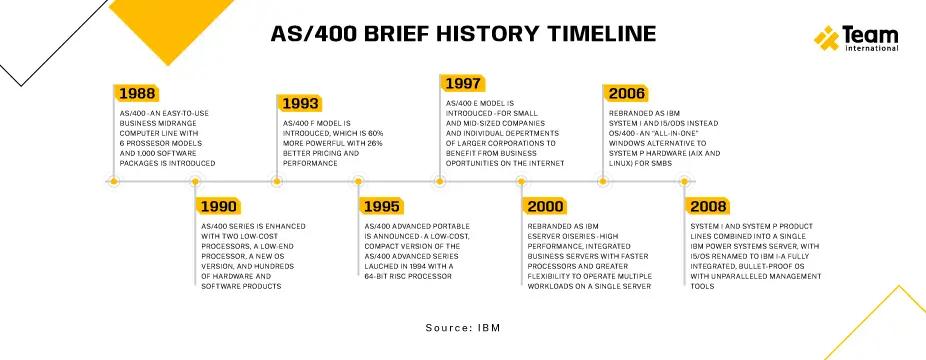Three decades is a very long time in the world of technology, but 1988 was still an important year.
That’s when the first well-known computer virus was created, an IP connection between Europe and North America was established, and the idea of a World Wide Web was discussed for the first time by Tim Berners-Lee. The history is rich, but there was another significant breakthrough that we’d like to focus on today in celebration of its three-decade anniversary. June 21, 1988, marks the creation of the IBM AS/400 computer system, known today as IBM Power Systems. What was the AS/400 system? Picture a supercomputer from any spaceship in a sci-fi movie—a huge black or white box with shiny knobs—and you won’t be too far off.
We imagine you’re thinking, “They deployed this AS/400 system in 1988, and you’re posting about it now? You might be mad, guys.” But trust us, it’s still relevant. So, the question becomes, “What is AS/400 used for thirty years later?” We’ve got an answer, so don’t rush to close this page! We’ll tell you how cool this invention really is, and you can be sure that Fortune 500 companies that capitalize on AS/400 modernization will support our statement.
What is the AS/400 system?
Before moving on to the reasons why this system is still in use and why it remains popular, one thing needs to be cleared up. The acronym stands for Application System/400, and it’s a 64-bit RISC server computing platform for businesses that ran the OS/400 operating system and supported Systems Network Architecture (SNA). Initially, the AS/400 system connected to SNA user interfaces via text-based 5250 terminals or 5250 emulation software on desktop PCs. Later, IBM gave OS/400 capabilities to turn the AS/400 into a web server and run interfaces from a standard web browser with TCP/IP.
This platform is one of the most used globally, with nearly 500,000 pieces sold by 1997. With it, companies can assign one administrator to manage a single centralized system for all their tech needs. An admin can manipulate the processor to do any job required at a particular time—launch applications, read mail, manage files, print, act as a database, and perform web server roles.
But the original AS/400 is no longer in use; it’s now just the generic name that groups together all of IBM’s midrange computers, such as the iSeries and IBM System. Just like with any other technology that evolves and progresses, such is the case with the IBM Power System.

Back to the future: what is AS/400 used for now?
Is the AS/400 system outdated? Some might say so, but we believe it remains a core pillar for tech ecosystems worldwide. The good old-school concept successfully remains a resilient foundation for next-generation innovations. Now that we’ve clarified that, let’s move on to discuss the AS/400 in more detail.
Generally, the AS/400 is used for mission-critical systems specific to industries that depend on reliability and stability, which is a priority for many. This is reflected in the variety of Fortune 500 companies that still use the computer system—Chevron, JP Morgan, and UPS, just to name a few. So, when people ask us, “What are the benefits of using AS/400?” we say it helps improve IT infrastructure’s scalability, robustness, and security.
What else is AS/400 still used for in IT these days? Let’s see what it has to offer.
1. A secure database with access controls
The platform’s DB2 provides impeccable productivity and consistent work without a database administrator’s supervision. Additionally, you get:
- A large volume data storage capacity
- Ability to safeguard data exit points
- Multiple access ways you can audit and secure
- Options to track data protection regulatory compliance
- AES256 encryption, tokenization, and scrambling to protect unique records
2. Database migration, conversion, and replication
You can use the AS/400 system’s DB replication software to convert and migrate information from and to any needed format on numerous OSs. It also updates your remote databases through common operations and helps you keep all databases synchronized 24/7. Source data won’t be locked. The AS/400 to cloud migration is also easy to accomplish and offers you greater flexibility, enhanced operational scalability, cost savings, and higher accessibility to modern technologies.
3. Comprehensive system security measures
Are there any AS/400 security vulnerabilities? Sure, it might be so. But for now, the AS/400 system offers you instead:
- Privileged access management (PAM)
- Syslog forwarding
- Multi-factor authentication (MFA)
- Security information and event management (SIEM)
- Password self-service (PSS)
4. In-built integration tools for a wide range of operations
- Auditing and ticket systems
- Big data analytics
- Price tag gadgets
- Occasion log sources for various metrics
- Support for Code400 and VisualAge RPG
5. Cost-effectiveness and ease of use
IBM Power Systems are perfect for those who need a productive and intuitive platform for creating client- and server-side applications without pushing your budget over the limits. Offering the lowest cost of administration and total cost of ownership, the AS/400 system is also incredibly resilient thanks to high uptime and stable performance.

5 reasons why AS/400 is still attractive for business owners
From its inception, the AS/400 system has provided the foundation for some of the most powerful systems in the world. Moreover, AS/400 performance optimization has enabled it to run the functions of an entire business. So, even if Fortune 500 companies aren’t looking further, it’s fair to say that the AS/400 is still going strong. Now that we’re past the ‘what is AS/400 used for?’ topic, the main questions from TEAM are: 1. what is the reason for such popularity? 2. and why is it so widespread among market leaders in high-tech, manufacturing, distribution, IT, and computer software?
In one word: flexibility. And this can be attributed to a couple of different things. Firstly, there’s its upward compatibility. You can run a program created in 1988 on a Power Systems server today. In fact, this is the reason why it is still referred to as the AS/400 system. Secondly, the AS400 can run a whole range of different languages, including SQL, Java, JavaScript, XML, PHP, JSON, Python, Perl, C, C++, and Ruby.
What’s more, it is:
- 1. Object-oriented. The IBM OS is application-centric, not processor-centric.
- 2. High-powered. BM Power Systems are reliable and high-performing thanks to up to 5 times more powerful CPUs than competitors.
- 3. Customer-centric. roduct lines are available for all consumer segments—low-cost entry-level platforms, powerful massively redundant servers, and ever-scalable ones for data centers.
- 4. Agnostic. Aside from IBM i, the iSeries provides multi-OS support—Linux, AIX, SUSE, and so on.
- 5. Cloud-friendly. The AS400 offers you an all-in-one managed cloud and automation solution that also reduces your TCO.
The future of AS/400: it still rides the wave in all of its shining glory
Looking over its history, it may come as no surprise that the AS/400 system has already celebrated its 30th birthday. As with any technology that has achieved longevity and stayed relevant, it needs to be adaptable and flexible. This is something that IBM has allocated a lot of time and effort to.
If you think the AS/400 is outdated just because of its age, then you are very wrong. IBM releases biannual updates with new hardware and software, and today’s version of IBM Power Systems is far more powerful and flexible than any of its predecessors. Of course, some market players part with the platform, but we see others double their investments in it.
So, there you have it; the AS/400 system is a prime example of how flexibility and openness are essential in establishing long-lasting and reliable technology. The original IBM Power Systems has provided a strong foundation for later versions, and the only thing that has stuck with the AS/400 has been its name.





